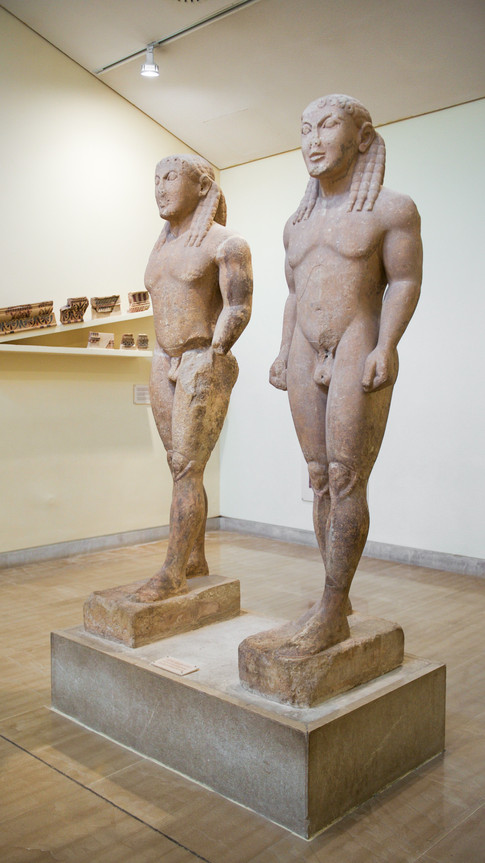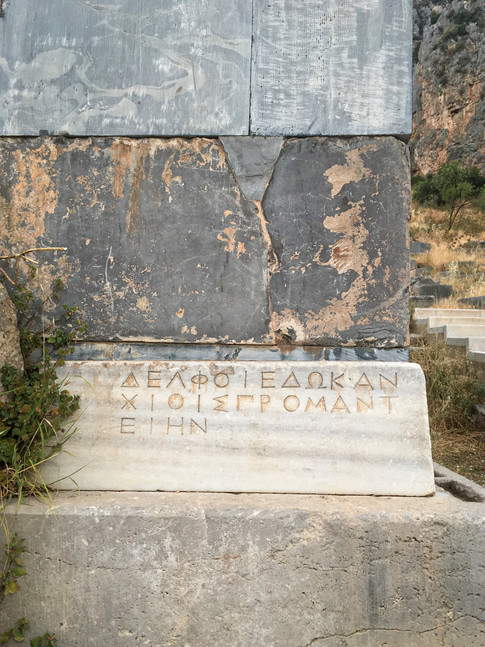Delphi, Greece - The Ancient Greek Center of the World
- Eryn

- Jul 5, 2021
- 6 min read
Updated: Feb 7, 2023

Delphi is tucked in the slopes and valleys formed by Mount Parnassus in central Greece. Having been considered the very center of the world and one of the most sacred sites in Ancient Greece, Delphi is surrounded by history, mysticism, and archaeological wonders. Walking past temples devoted to Greek gods and structures that are thousands of years old, our trip to Delphi was truly a trek amidst the remnants of a bygone civilization.
Especially since I was admittedly a big fan of the Percy Jackson novels in primary school (anyone else?!), I was more than excited to visit Delphi. It is the actual setting of Greek myths and even figures including the famed Oracle of Delphi who, serving as a bridge between humans the gods, often changed the course of history itself with her prophecies. Tales of Greek mythology and the past aside, visiting the archaeological site today is a scenic experience. Perhaps in ways that are similar to Meteora, Delphi is intertwined with the soft colors of the surrounding nature, rock cliff faces, and lush greenery. Read on to take a hike through the history and grounds of Delphi with me, one of Greece's most beautiful destinations and UNESCO World Heritage Sites.

Archaeological Museum of Delphi
At the entrance to the ancient site and at the base of the slope upon which it stands lies the Archaeological Museum of Delphi. Holding the many treasures that were excavated from the ruins of Delphi, the museum details the history of the sacred site.

Among the museum's most notable artifacts are a pair of kouros statues, matching sculptures of two male figures that, though discovered between 1893 and 1894, likely date all the way back to 580 BCE! The highlight of the museum, however, is perhaps the Sphinx of Naxos, a marble statue of a Greek sphinx with the head of a woman and the body of a winged lioness. Fragments of the statue were first found in 1860 while the rest followed later in 1893. Standing over 2 meters tall, the marble sphinx is from 560 BCE and would have stood on a towering 10-meter-tall column beside the Temple of Apollo, which we will visit later.
Delphi in History and Mythology
Although these statues are already thousands of years old, evidence suggests settlements in Delphi stretch back even farther in time. Artifacts from the 15th century BCE, late Mycenaean times, and even 4000 BCE toward the end of the Neolithic period have been found in the area. However, the main attraction of the site is still what remains from the era of Delphi that the statues came from.
Beginning in the 8th century BCE, Cretan priests of the cult of Apollo, the god of music, archery, and prophecy among others, came to Delphi. In the legends from Greek mythology, the priests are said to have followed Apollo who, in the form of a dolphin, led them to Delphi's port. There, they established the sanctuary to the god and his oracle, building the many temples and structures that can still be seen today. The oracle, in particular, is the main source of Delphi's prestige in the Ancient Greek world and brought the site to its height during the 6th to 4th centuries BCE.

Known as the Oracle of Delphi, the high priestess Pythia was consulted for all manners of business and was a coveted chance to gain the wisdom and insight of the gods. By sitting on a tripod chair while inhaling fumes and gases that escaped from the earth, she would fall into a trance and utter incomprehensible "messages" from Apollo in response to pilgrims' queries. Her utterings would then be translated by other priests, and the Pythia was offered lavish offerings in return for her services. The oracle was believed to be as old as time and an accurate predictor of events including the Trojan War. Being among the most powerful women in classical history, the oracle truly decided fate with her prophecies and was even the focus of five Sacred Wars as powers fought for control of Delphi.
So, like pilgrims to the famed Oracle of Delphi, we passed the museum and followed the path of the Sacred Way, the same route that Ancient Greek visitors would have taken, and snaked up the mountain to see what the Sanctuary of Apollo has to offer.

Sanctuary of Apollo
A complex of temples, buildings, and even entertainment venues, the Sanctuary of Apollo is where most of Delphi's structures lie. After passing different minor ruins as you make your way up the Sacred Way, you'll come across a strange, smooth, and almost bullet-shaped rock. This is the Omphalos or Navel Stone and it is what marks the navel of the world. According to the Greek myth, Zeus, the king of the gods himself, placed the rock here after sending two eagles to find the center.

Beside the Omphalos of Delphi is then the Treasury of the Athenians. Though it is only one of the many treasuries in the sanctuary, it is the only one that has been reconstructed with its original bricks, and the Athenian Treasury truly catches your eye. With the different treasuries representing different city-states across Greece, each was used to hold offerings from their respective regions as a show of power and wealth. This one is from Athens as the name suggests. With inscriptions carved across its bricks, perhaps hiding stories of old, the Athenian Treasury is beautiful as it suddenly rises out of the surrounding ruins.


As you follow the curve of the Sacred Way, directly above the Athenian Treasury stands the Temple of Apollo. This was the most important part of Delphi as it was the center of worship and where the Oracle of Delphi would have operated. Unfortunately, only the foundations and a few of its columns that were built in the 4th century BCE remain today, but from these alone, you can really see the scale of the original structure. I can't imagine what it might have looked like in its prime!


After seeing the Temple of Apollo, the major structures that are now left to be seen are the amphitheater and stadium of Delphi, the entertainment venues. Not only was Delphi a religious center in Ancient Greece, but it was also the site of the Pythian Games, second in importance only to the Olympics. Named after the oracle, Pythia, the games were held every four years since 582 BCE, and judging by the number of seats available in each structure, Delphi must have been bustling. While the amphitheater can host about 4,500 spectators, the stadium would have been able to hold 6,500 people! The stadium is an incredible 178 meters long, and the amphitheater provides some of the best views overlooking the rest of the sanctuary.




Though we had now come to the end of our journey on the Sacred Way in the Sanctuary of Apollo, Delphi still has more to offer - the iconic structure that comes to mind when you think of the ancient site.
Sanctuary of Athena Pronaia
Almost as if it knew we had saved the best for last, the sky cleared by the time we reached the Sanctuary of Athena Pronaia. Literally meaning Athena who comes before the temple, that is, the Temple of Apollo, Ancient Greek visitors would have historically passed this sanctuary before they reached the Sacred Way. What immediately draws your attention in the sanctuary is the remains of the Tholos of Delphi, a circular building supported by surrounding columns that was built between 380 and 370 BCE. It is perhaps the most breathtaking of structures in the archaeological site. As you're surrounded by the mountains, the trees, the sunshine, and the wind, maybe it's the seeming isolation that brings out the beauty in the tholos. Nevertheless, the picturesque pillars and the detail in the remaining arch make the tholos the highlight of Delphi.





Delphi is only a day trip away from Athens, Greece's capital city, and is one of the most memorable places we visited during our time in the country. With its captivating history, mythology, and both its archaeological and natural beauty, Delphi is a destination you cannot miss.
Sources:
We visited Delphi in 2017 during our year-long trip around the world. Click on the link to read more!


















Comments